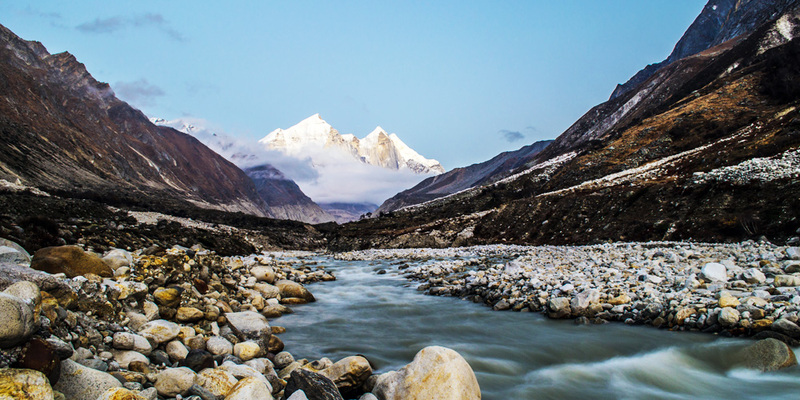India has always been considered the land of pilgrimages from time immemorial. Among the various pilgrimage places where people flock together for sacred worship, the Chaar Dham Yatra stands out as one of the most-visited and significant places of holy expedition.
The Chaar Dhaam is known to be the sacred journey through the four Dhams, namely- Gangotri, Yamunotri, Kedarnath and Badrinath. There are hallowed shrines in each of these locations founded by Adi Shankaracharya to which Hindu believers aspire to journey to, at least once in their lifetime. Therefore, in this article we go over all that you need to know as an eager visitor of the Chaar Dham.
Why Should You Go for Char Dham Yatra?
To answer the question, what is Chardham yatra, we must look into the Hindu philosophy, where many believe that a visit to the Chaar Dham is a journey of purification of one’s soul. In this holy visit, all bhakts are cleansed of their sins if they complete the full journey and attain Moksha.
In order to complete the journey successfully, one must endure a lot of physical as well as mental labour despite their incapabilities to achieve true salvation. As per the order of Parikrama, Hindus start from the Yamunotri (which is in the left) and continue towards Gangotri, to Kedarnath and finally reach Badrinath. This is where believers attain Moksha as they conclude their Chaar Dham Yatra successfully.
Char Dham Yatra Route Map Overview
Millions of people gather at the start of this strenuous pilgrimage, keeping their weaknesses at bay. Both national and international tourists flock at these places of holy worship to have an experience of a lifetime and get a chance to feel closer to heaven on earth. Here are the most important Char Dham yatra details you need.
1. Yamunotri

First of the Chardham yatra places is the Yamunotri temple. Built in the 29th century, it is located deep inside the picturesque Garhwal Himalaya and stands in all it’s elegance. The Yamunotri temple rests at an altitude of 3,291 metres above sea level, so journeying here is quite a strenuous task.
The majestic Yamuna River flows right beside the temple and Deity Yamuna is represented as silver-wrapped idol clad with garlands and serene clothing. All devotees offer prayers at the feet of the deity made of black marble.
The atmosphere of the Yamunotri temple is one of awe. With the hot springs and lush vegetation, it stands tall as one of the most sacred pilgrimage places, that attracts all believers, non-believers and pure adventure seekers to be a part of a holy espionage every year, when the Chaar Dham opens its gates to tourists.
Top Tourist Attractions near Yamunotri
Here are some of the most well-known tourist sites in the vicinity of Yamunotri that you ought to visit:
- Divya Shila
Prior to entering Yamunotri, it is customary for all devotees to do poojas at Divya Shila. It is a pillar of rock at Yamunotri that is close to the Surya Kund.
- Barkot
It is a little town 49 kilometers from Yamunotri that has an ancient temple that is perfect for meditation. It is situated on the route to Yamunotri.
- Kharsali
One of Yamunotri’s most popular tourist destinations is Kharsali, which has breathtaking meadows and coniferous trees that surround the area and showcase nature’s splendor at its finest.
Read also: Chaardham Yatra by Helicopter from Dehradun
2. Gangotri

The second place of the holy pilgrimage is the Gangotri temple. This temple was built in the 18th century by Gorkha Amar Singh Thapa and is located on the bank of the river Bhagirathi. The Bhagirathi-Hooghly River is considered one of the major rivers of India and it finds its origin in the Gangotri glacier which is present at the upper level of Gangotri.
The temple lies within a serene atmosphere where Goddess Ganga is worshipped, it rests amongst Rocky Mountains and coniferous forests of Oak, Pink and Deodar. The King Bhagirathi Shila is close to the Gangotri temple where Lord Shiva is worshipped and it is also a significant tourist spot near Gangotri.
The ganga river water is used for all purposes from utilisation in the worship within the temple to household uses near Gangotri. This water is believed to bear nectar and enriched with minerals that soothes the poison within Lord Shiva’s throat.
Top Tourist Attractions near Gangotri
Here are a few of the most popular tourist attractions in the area of Gangotri that you should check out:
- Glacier Gomukh
The Gangotri Glacier is renowned for producing Ganges water that is 100 percent pure and devoid of any contaminants.
- Tapovan
A hike to Tapovan, a lovely meadow that encircles the peaks, sharpens the perception of the nearby peaks and ranges.
- Vishwanath Temple
A Shivling that is 90 cm in girth and is 60 cm tall is housed at this revered sanctuary. The Skanda Puran has a description of Lord Vishwanath Temple, one of the most well-known temples. The local bus stop in Uttarkashi is at a short distance from the temple.
3. Kedarnath

Coming to our third destination among the Char Dham places, we have Kedarnath which is a temple dedicated to Lord Shiva. It is not just any temple, Kedarnath has been termed as a historically symbolic place of worship where Lord Shiva is seen in his Sadashiva form inside the temple. The temple is used both for worship as well as a Mandap due to which it is locally called the Garbha Griha.
The Nandi bull, Lord Shiva’s most loyal attendant, rests outside guarding the gates. The temple has a large assembly hall where the figures and architecture of various gods and goddesses adorn the walls.
There lies a conical rock structure in the depths of the temple which is worshiped as another form of Lord Shiva. After the 2013 Kedarnath Flood, the temple has been reformed in various ways. Although the original structure within is retained, new routes of travel, bath and guest houses, homestays and much more have sprung out lining the main temple.
Top Tourist Attractions near Kedarnath
Here are the most renowned tourist attractions near Kedarnath that you should not miss:
- Shankaracharya Samadhi
The devotees portray this as a beautiful and serene setting. The majestic temple in the background adds to the tranquillity. It is thought that Adiguru Shankracharya attained samadhi here.
- Vasuki Tal
The Chaukhamba peaks may be seen well from this magnificent lake, which is 6 kilometres above sea level and encircled by tall mountains.
- Temple of Bhairavnath
One-mile separates Bhairon Mandir and Kedarnath Temple. It is thought that the god in the guise of Bhairavnath guards the Kedarnath temple when it is closed for the winter because of severe snowfall.
4. Badrinath

Located within the Badrinath town is the awe-inspiring Badrinath temple. It is the most famous location among all the sequence of Chaar Dham Yatra. The temple of Badrinarayan is built to honour Lord Vishnu. Just like the Kedarnath temple, the Badrinath temple has the Garbha Griha, and Sabha Mandap, with an additional availability for the Darshan Mandap.
Since it’s the last spot of the holy personage, many people flock to the Badrinath temple just for a visit. The Badrinath temple is made of stone and stands around 50 feet tall with stone carvings on every wall depicting Northern Indian Architecture. The main entrance is huge and decorated with figurines and stories of Lord Vishnu, known as the Singhdwar, and is also guilded with gold gilt roof and cupola on the top.
Daily Puja is performed at the Badrinarayan temple wherein the main priest concludes it with a holy dip in the Tapta Kund. The puja is openly performed in front of all devotees and no one is barred from entering to catch a glimpse of the arti.
Top Tourist Attractions near Badrinath
Here are the most-popular tourist sites near Badrinath, that you must visit:
- Neelkanth
The ‘Garhwal Queen,’ as it is often known, is a snowy summit in the shape of a pyramid that provides the background of the Badrinath temple. A side valley leads from the Badrinath shrine to the conical-shaped Neelkanth hill (6600 mts).
- Charan Paduka
A lovely valley that is covered in wild flowers in the summertime is only 3 miles away. Here is a stone with Lord Vishnu’s footsteps on it.
- Satopanth
It is a triangle lake surrounded by snow-capped peaks named for the Hindu gods Mahesh, Vishnu, and Brahma, and every Ekadasi of the Hindu calendar, these Gods are said to bathe in this Sarovar.
Conclusions
The Chaar Dham Yatra is considered as one among the five duties undertaken by Hindu believers. It is known as Tirth Yatra and allows an individual to gain humility, faith and willpower while overcoming difficulties in their life. The devotee must travel through challenging locations and truly giving oneself to the deity by leaving all their problems at the start. This experience is for all to have a life-changing affirmation while attaining Moksha in association with the Divine power.
FAQs
Which God is worshipped in Badrinath?
Badrinath is one of the destinations within the Chaar Dham Yatra. It is the last step towards completion of the holy pilgrimage undertaken by a religious Hindu believer, and Lord Vishnu resides at the Badrinath temple. The town of Badrinath is blessed by the Skanda Purana that is said to be holier than all other shrines that exist in heaven.
What is the Kedarnath Yatra starting point?
The Kedarnath Yatra is a long way uphill and the summit zone is the hardest to walk. The starting point of the Kedarnath visit is from Gaurikund where all attendees can book ponies and palanquins to travel uphill. However, those who are fit health-wise, and confident enough to undergo the rigorous journey, can also walk up to the summit of Kedarnath.
What is the total Char Dham distance?
The 4 Dham in India is a journey of salvation from all sin. It is fraught with a lot of risky courses and rigorous physical activities but completing this journey will ensure one’s purification. The journey is approximately 1,607 kilometres from the starting point, which is the Yamunotri, going around Gangotri, all the way to Kedarnath and then Badrinath which is the final ending location for the personage.



